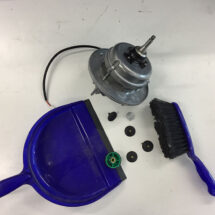
The cells in our body contain numerous molecular machines that carry out nearly all biological processes essential for life. These machines are built from proteins that are often assembled into complex structures. For example ribosomes contain 80 distinct proteins on a scaffold of four different RNAs. The assembly of such structures from so many parts is a complicated process and inevitably results in ‘leftover’ proteins. How cells get rid of orphan proteins that have not been assembled into their final structures has, until now, been unclear. New research from Manu Hegde’s group in the LMB’s Cell Biology Division has led to the discovery of a factor that is responsible for finding orphan proteins and tagging them for degradation.
Kota Yanagitani, a former postdoc in Manu’s group, used an artificial mutant protein to search for factors that recognise aberrant proteins in the cytosol of cells. He found that a ubiquitin-conjugating enzyme, called UBE2O, directly recognises the aberrant protein and tags it with several ubiquitin molecules. Ubiquitin often serves as a degradation signal, suggesting that UBE2O might be a quality control factor for disposing of mutant proteins. Kota then searched for the natural targets of this potential disposal pathway.
A 20-year old observation that UBE2O is highly expressed in red blood cell precursors provided a clue. Red blood cell precursors produce enormous amounts of haemoglobin, a protein composed of two alpha and two beta subunits. Kota found that alpha subunits that did not assemble into mature haemoglobin are targets for UBE2O ubiquitination. Excess alpha subunits are prone to aggregation, suggesting that its prompt disposal by UBE2O might be important for preserving normal red blood cell function. Indeed, parallel research from Dan Finley’s group at Harvard Medical School has found that mice with mutant UBE2O develop anaemia and contain excess alpha subunits in their red blood cells. Thus, the haemoglobin experiments suggested that UBE2O gets rid of orphan subunits. This inspired Kota and Szymon Juszkiewicz, a PhD student in Manu’s group, to examine the subunits of one of the most complex cellular structures – the ribosome. They found that excess ribosomal proteins are indeed targets for UBE2O-mediated degradation, thereby generalising the concept of UBE2O function in degradation of orphans.
The accumulation of incorrectly folded or unassembled proteins can cause cellular damage and is associated with various diseases, ranging from diabetes to neurodegeneration. Identifying the cellular pathways responsible for degrading unnecessary or aberrant proteins provides insight into how normal health is maintained. Furthermore, cancer cells rely heavily on protein quality control because their rapid growth relies on the synthesis of large quantities of proteins, many of which are mutated. Thus, quality control factors such as UBE2O are especially important in cancer cells, making it a potential therapeutic target.
This work was funded by the MRC, the Japan Society for the Promotion of Science and the Uehara Memorial Foundation.
Further references:
Paper in Science
Manu’s group page
Science Perspective: New developments for protein quality control